John places an alarm clock inside a box as shown in the given figure. He then creates a vacuum inside the box. When the alarm goes on, John does not hear the alarm-sound.
John does not hear the alarm sound because
the walls of the box block the sound
sound cannot travel through vacuum
there is no medium between John and the box
the inside wall of the box reflects the sound back
Step-by-Step Solution:
1. Understanding Sound: Sound is a type of mechanical wave that is produced by vibrations. It requires a medium (like air, water, or solids) to travel through.
2. Creating a Vacuum: When John places the alarm clock inside a box and creates a vacuum, he removes all the air from the box. This means there is no medium present inside the box for the sound waves to travel through.
3. Sound Production: When the alarm clock goes off, it produces sound waves through vibrations. However, these sound waves need a medium to propagate.
4. Propagation of Sound: In normal conditions, sound waves travel by vibrating the particles of the medium (air in this case). Without a medium, the sound waves cannot move forward.
5. Conclusion: Since there is no medium (air) inside the vacuum box, the sound waves produced by the alarm clock cannot propagate, and therefore, John does not hear the alarm sound.
Final Answer: John does not hear the alarm sound because sound cannot travel through a vacuum, as it requires a medium to propagate.
---
Topper's Solved these Questions
- SOUNDBOOK - BEIITIANSCHAPTER - SOUNDEXERCISE - IIT JEE Worksheet (I. Single Correct Answer Type)
10 Videos
- SOUNDBOOK - BEIITIANSCHAPTER - SOUNDEXERCISE - IIT JEE Worksheet (II. Multiple Correct Answer Type)
5 Videos
- SOUNDBOOK - BEIITIANSCHAPTER - SOUNDEXERCISE - Summative Worksheet
10 Videos
- MOTIONBOOK - BEIITIANSCHAPTER - MOTIONEXERCISE - IIT JEE WORKSHEET (MATIRX MATCHING)
1 Videos
- WIND, STROM AND CYCLONESBOOK - BEIITIANSCHAPTER - WIND, STROM AND CYCLONESEXERCISE - IIT JEE Worksheet (II. Multiple Correct Answer Type)
1 Videos
Similar Questions
There is a hollow glass partition in a room. It divides the room in two compartments. Two brothers X and Y are sitting in each compartment. An alarm clock, which is placed inside the glass partition, is producing sound, as shown in the given figure. Both brothers are able to hear the sound. All the air from within the glass partition is removed with the help of a vacuum pump.
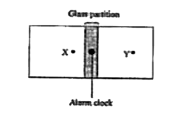
After evacuating the partition completely,
View SolutionAn electric drum is enclosed inside a specially designed closed glass chamber, as shown in the given figure. On switching the current, the hammer repeatedly strikes the membrane of the drum. Hence, the membrane vibrates and produces sound that can be heard at a distance. Now, the chamber is evacuated by closing the switch of the vacuum pump.

As the chamber is evacuated, the
View Solution
Knowledge Check
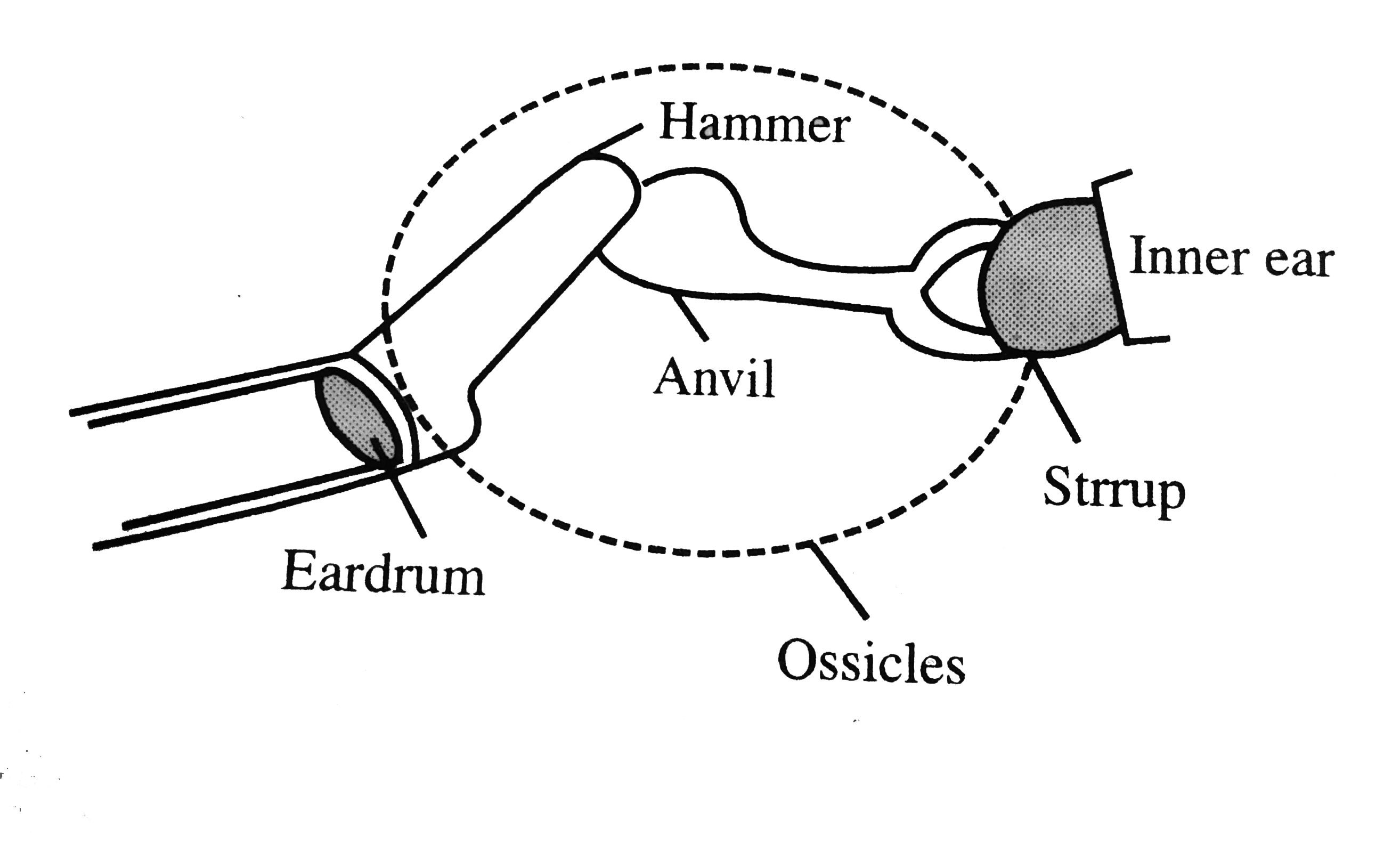
When a sound wave enters the ear, it sets the eardrum into oscillation, which in turn causes oscillation of 3 tiny bones in the middle ear called ossicles. This oscillation is finally transmitted to the fluid filled in inner portion of the ear termed as inner ear, the motion of the fluid disturbs hair cells within the inner ear which transmit nerve impulses to the brain with the information that a sound is present. The theree bones present in the middle ear are named as hammer, anvil and stirrup. Out of these the stirrup is the smallest one and this only connects the middle ear to inner ear as shown in the figure below. The area of stirrup and its extent of connection with the inner ear limits the sensitivity of the human ear consider a person's ear whose moving part of the eardrum has an area of about 50mm2 and the area of stirrup is about 5mm2. The mass of ossicles is negligible. As a result, force exerted by sound wave in air on eardum and ossicles is same as the force exerted by ossicles on the inner ear. Consider a sound wave having maximum pressure fluctuation of 4×10−2Pa from its normal equilibrium pressure value which is equal to 105Pa. Frequency of sound wave in air is 332ms. Velocity of sound wave in fluid (present in inner ear) is 1500ms. Bulk modulus of air is 1.42×105Pa. Bulk modulus of fluid is 2.18×109Pa.
Q. This person (without hearing aid machine) is sitting inside a busy restaurant where average sound intensity is 3.2×10−5Wm2. How much energy in the form of sound is taken up by the person in his meal time of 1 h?A1.2×10−5JB1.8×10−4JC2.4×10−5JD3.6×10−4J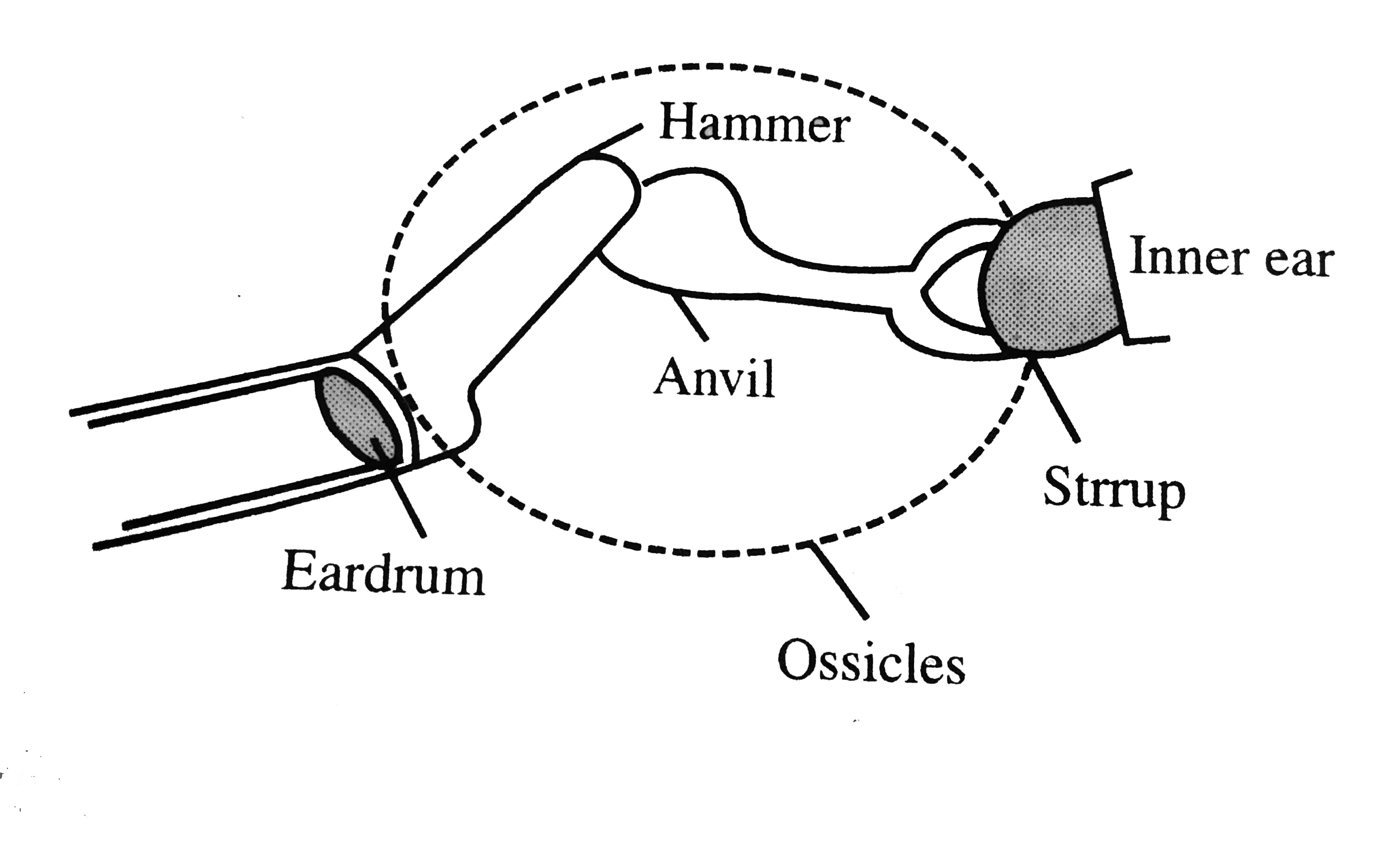
When a sound wave enters the ear, it sets the eardrum into oscillation, which in turn causes oscillation of 3 tiny bones in the middle ear called ossicles. This oscillation is finally transmitted to the fluid filled in inner portion of the ear termed as inner ear, the motion of the fluid disturbs hair cells within the inner ear which transmit nerve impulses to the brain with the information that a sound is present. The theree bones present in the middle ear are named as hammer, anvil and stirrup. Out of these the stirrup is the smallest one and this only connects the middle ear to inner ear as shown in the figure below. The area of stirrup and its extent of connection with the inner ear limits the sensitivity of the human ear consider a person's ear whose moving part of the eardrum has an area of about 50mm2 and the area of stirrup is about 5mm2. The mass of ossicles is negligible. As a result, force exerted by sound wave in air on eardum and ossicles is same as the force exerted by ossicles on the inner ear. Consider a sound wave having maximum pressure fluctuation of 4×10−2Pa from its normal equilibrium pressure value which is equal to 105Pa. Frequency of sound wave in air is 332ms. Velocity of sound wave in fluid (present in inner ear) is 1500ms. Bulk modulus of air is 1.42×105Pa. Bulk modulus of fluid is 2.18×109Pa.
Q. If the person is using an hearing aid, which increase the intensity of given sound wave change as perceived by inner ear?A1000B100C10000Dnone of these
A large , heavy box is sliding without friction down a smooth plane of inclination θ . From a point P on the bottom of the box , a particle is projected inside the box . The initial speed of the particle with respect to the box is u , and the direction of projection makes an angle α with the bottom as shown in Figure .
(a) Find the distance along the bottom of the box between the point of projection p and the point Q where the particle lands . ( Assume that the particle does not hit any other surface of the box . Neglect air resistance .)
(b) If the horizontal displacement of the particle as seen by an observer on the ground is zero , find the speed of the box with respect to the ground at the instant when particle was projected .
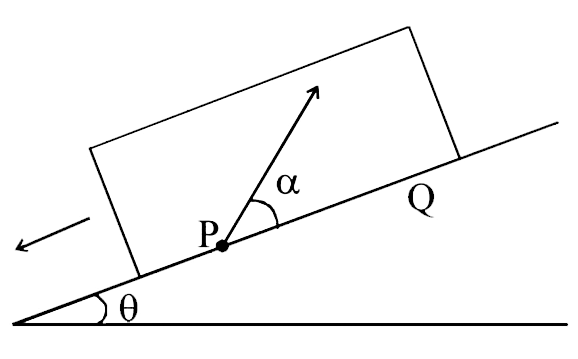
View SolutionThree boys Ravi, John and Asif stand in a straight line as shown in figure. Ravi and Asif fire crackers at the same instant of time. John hears the first sound after 2 s and the second sound after 2.5 s. Determine the distance between Ravi and Asif. The velocity of sound in air is 330ms−1.

View SolutionA man stationed between two parallel cliffs fires a gun. He hears the first echo after 1.5s and the next after 2.5s. What is the distance between the cliffs and when does the hear the third echo ? Take the speed of sound in air as 340m/s.
View SolutionA man stationed between two parallel cliffs fires a gun. He hears the first echo after 1.5s and the next after 2.5s. What is the distance between the cliffs and when does the hear the third echo ? Take the speed of sound in air as 340m/s.
View SolutionA closed cubical box of negligible mass has large number of spherical balls arranged neatly inside it as shown in the figure. When placed in water, the box floats with 80% of its volume remaining. Submerged. What is specifc gravity of material of the balls? Neglect thickness of the wall of the box.
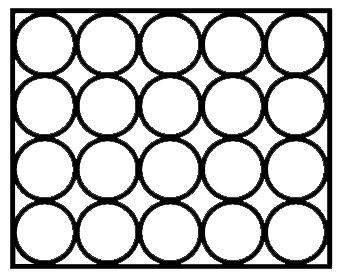
View SolutionRead the following extractand answer the questions given below
In more rectent times gandhiji perphasps is one who assiduously brushed aside adulation to remain a free nodbdy at the congress session when the star of the session stunned everybody by cleaning up the latrines his act was calculated to purge congresss workers of theeir false sense of status and so to return the movement to its down to earth roots the point of guarding against becoming a self defeating somebody apppies to the upbringing of children as well doting parents of ten stunt the natural growth of their childeren through excessive adulation common place acts and utterances of the child are praised and quoted beyond reason talent that otherwise might have flowered under proper trainging is lauded to the extent of killling it
Johan sturart mill 's Education and training began very early at an age when many kids can barely lisp a few words he had learnt enough greek and latin to read the classic in the original before he was five he had read more than what many scholars normally read in their career did this make child john feet heady gt? No because he tells us his father alwasy made him believe that there was nothing extraordinary about his achievement that he eas doing only what anybody is capable of doing mill was made to believe that othere boys of his age had in fact grossly understimated their capabilites and were wasting their early years striving for too little
How did john stuart Mill show extraordinary progress at this early age?
View Solution
